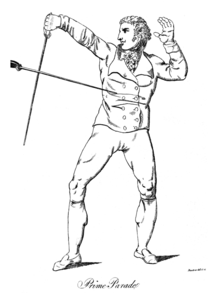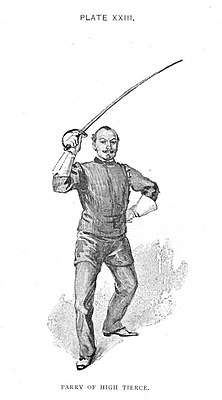Parry (fencing)
A parry is a fencing bladework maneuver intended to deflect or block an incoming attack.

Execution
To execute a parry, fencers strike the opponent's foible, or the area near the tip of the blade, with their forte, or the part of the blade near the bell guard (or handle) of the weapon. This deflects the opponent's blade away from them, protecting them and placing them in a good position to strike back. Approximations of the precise parries are made often during bouts, but are usually accurate enough to be classed as parries.
In épée, because of absence of priority rules (see right-of-way), a parry can be classed as any deflection of the blade that prevents the opponent's attack from landing.
Use
The primary function of a parry is to prevent an opponent's attack from landing. During a bout, parries are commenced from the "en garde" (neutral) position, when an opponent's attack is considered threatening.
A parry is usually followed by a riposte, which is an attack back against the original attacker. More advanced fencers can, instead of immediately riposting after successfully taking a parry, initiate a prise de fer ("taking of the blade") in which they move the opponent's blade to a different position and then hit them.
In foil and sabre, the rules governing the parry give it tactical significance as well: there is a rule known as priority, or "right-of-way." The first fencer to commence an attack gains the priority. If the attack results in a successful hit, only the fencer who has the priority is awarded a touch (regardless of whether the fencer without right of way has made a touch). A successful parry causes the attack to fail, and hence the priority is transferred to the defender (who is now the attacker). Taking a parry, therefore, means that the attacker is in an awkward position (with their arm extended and sometimes off-balance), having just committed to attacking, and the defender has the priority, as well as the best position to riposte, or strike after parrying.
Classification
There are eight parries in the classical systems of épée and foil fencing. Parries are classified based on three attributes: 1) The direction of the blade in relation to the hand: up or down. 2) The position of the blade in relation to the fencing line: inside or outside. 3) The rotation of the wrist in the hand holding the weapon: supinated (palm up) or pronated (palm down).[3]
The parries are numbered from one to eight, with the numbers often referred to by the old French terms: prime, seconde, tierce, quarte, quinte, sixte, septième, octave.
For a right-handed fencer, the inside line is to the left, and the outside line is to the right; thus the parries prime, quarte, and septime deflect the opponent's blade to the left (inside), while the parries seconde, tierce, sixte, and octave deflect the opponent's blade to the right (outside), as shown.
The phrase "counter-parry" indicates a parry that is done in response to an opponent's parry (that is, to block the riposte which follows up the opponent's parry.) This is not to be confused with the contra- (or "circular") parry, in which a semicircular motion is used to make a parry from the opposite side from the attack.
Because sabre parries defend against both cuts (attacks with the edge) as well as thrusts (attacks with the point),[4] the sabre parries are slightly different from the corresponding épée or foil parries; most notably the parry 5 ("quinte"), which defends against a head cut in sabre (an attack that is not allowed in foil or épée).
| Name | Description (foil and épée) | Description (sabre) | Diagram |
|---|---|---|---|
| Prime - Parry 1 | Blade down and to the inside, wrist pronated. Sometimes known as the "Looking at your watch" Parry. | Blade points down and "cutting edge" faces away from the fencer's chest side. To stop low-line cut to chest. |  Illustration of the prime parry (from Roworth's manual of defense 1798)[5]. |
| Seconde - Parry 2 | Blade down and to the outside, wrist pronated. | Arm half-extended laterally, blade pointing forward with downward incline, cutting edge facing away fencer's flank side. To stop low-line cut to flank. | |
| Tierce - Parry 3 | Blade up and to the outside, wrist pronated. Not often used in Foil, and in Épée only as a block to wrist flicks. | Standard en garde but rotated so cutting edge faces further in the flank direction, i.e. guard kept low, sword upright with a slight forward tilt, cutting edge facing 45° to the outside. To stop outside high-line cut to flank or shoulder. |  |
| Quarte - Parry 4 | Blade up and to the inside, wrist supinated.[6]
This parry can be Lateral or Circular, as can most all parries. The Contre Parry. The Circular Parry, also known as "Contre Quarte", is a circular or oval shape. It begins in either the neutral or quarte position, and with a twist of the wrist it ends in the carte parry. |
Similar to tierce on the chest side or prime flipped upside-down; guard low, cutting edge facing away from chest, sword upright with slight chest-direction tilt. To stop high-line cut to chest. | |
| Quinte - Parry 5 | Blade up and to the inside, wrist pronated.[7] Not often used in Foil or Épée | Blade held up almost horizontally with bent arm, cutting edge facing upward and forward, blade has a slight tilt meaning that the point is higher than the guard. To stop cut to head. | .png) Parry quinte in sabre (from Patten's 1861 manual)[8]. |
| Sixte - Parry 6 | Blade up and to the outside, wrist supinated.
This parry can be Lateral or Circular. The Lateral Parry is from Quarte to Sixte. The Circular Parry, also known as "Contra Sixte", is a D shaped parry, dropping the points and bringing it up on the inside bringing your point back towards your En Guard line. |
The arm position is a mirror image of quinte (supinated, forearm vertical on the quarte side of the head). Point is diagonal across the body covering the head, but towards the opponent, and slightly upwards (or forwards for a direct riposte in opposition). To stop cut to head. (Rarely or never used in modern sabre) | |
| Septime - Parry 7 | Blade down and to the inside, wrist supinated. Point dropped, the wrist is in the same place as in Quarte.
This parry is semi-circular, the point is dropped from Quarte to Septime (or the opposite). |
Very similar to Tierce, but the blade is held upside down, with the palm facing and being level with the temple. To stop cut to the flank and back. (Rarely used in modern sabre) | |
| Octave - Parry 8 | Blade down and to the outside, wrist supinated. Point is dropped, the wrist is in the same place as in Sixte.
This parry is semi-circular, the point is dropped from Sixte to Octave (or the opposite). |
(not used in sabre) | |
| Neuvieme - "Parry 9" | In addition to the eight classic parries, several parries are proposed as "parry nine". It is usually considered a parry that protects the back, point down.[9][10] |
References
- Rondelle, Louis, Foil and sabre; a grammar of fencing in detailed lessons for professor and pupil, Estes and Lauriat, Boston, 1892.
- Carr, Jonathan, "An introduction to two late 19th century Fencing Manuals", Victorian Fencing Society, April 2, 2014. Retrieved 25 June 2019.
- Hamper, Rich, Fencing Glossary, The Rth Dimension, 2017. Retrieved 25 June 2019.
- Hutton, Alfred,Cold Steel: a Practical Treatise on the Sabre, Clowes and Sons, London, 1889. See also version at Meyer Free Scholars. Retrieved 25 June 2019.
- Roworth, Charles, The Art of Defence on Foot with the Broadsword and Sabre, uniting the Scotch and Austrian methods into one Regular System, 1798 (2nd edition)
- de Beaumont, C.L. Fencing: Ancient Art and Modern Sport, 1960. p. 68.
- de Beaumont, C.L. Fencing: Ancient Art and Modern Sport, 1960. p. 71.
- Patten, George, Patten’s Cavalry Drill and Sabre Exercise, Compiled Agreeably to the Latest Regulations of the War Department, J. W. Fortune, NY, October 1861 (1864 edition)
- Scandaglio, Fencing Dictionary. See also Glossary of terms. (accessed 27 Jan 2015)
- Glise, Anthony L., Beginning Foil Fencing — In Practice and Combat, Aevia Publications, 2005. p. 15.
- Epee Fencing: A Complete System - Imre Vass (SKA Swordplay Books)
- Know the Game: Fencing
- Fencing: Techniques of Foil, Épée and Sabre - Brian Pitman
- Theory, Methods and Exercises in Fencing - Ziemowit Wojciechowski
External links
| Wikimedia Commons has media related to Parry (fencing). |

